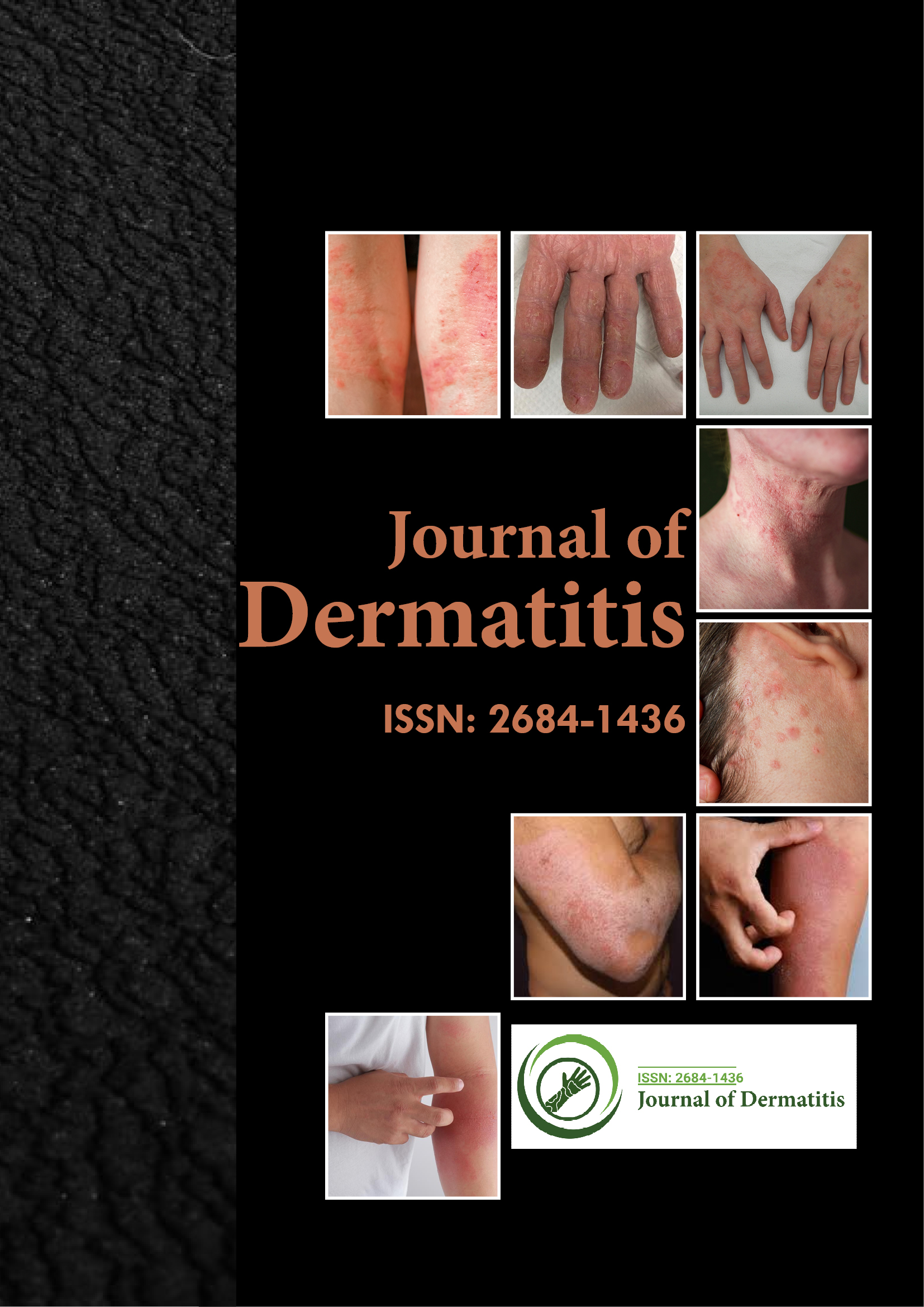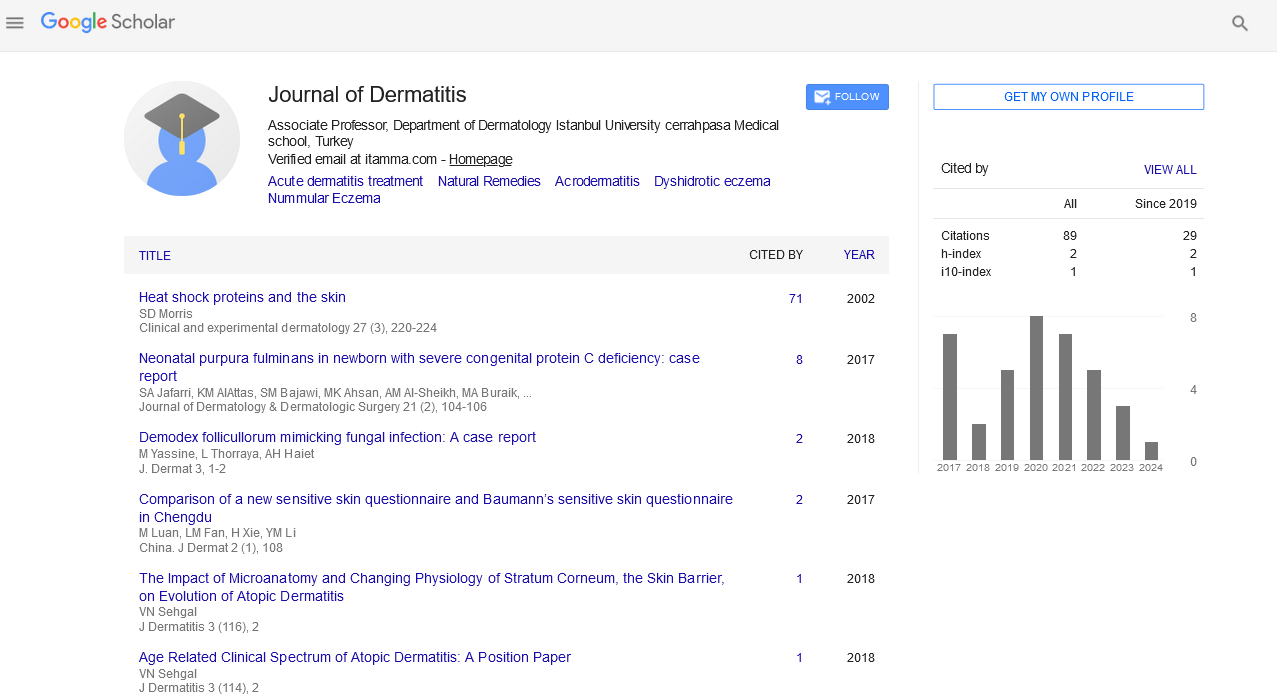Indexed In
- RefSeek
- Hamdard University
- EBSCO A-Z
- Euro Pub
- Google Scholar
Useful Links
Share This Page
Journal Flyer

Open Access Journals
- Agri and Aquaculture
- Biochemistry
- Bioinformatics & Systems Biology
- Business & Management
- Chemistry
- Clinical Sciences
- Engineering
- Food & Nutrition
- General Science
- Genetics & Molecular Biology
- Immunology & Microbiology
- Medical Sciences
- Neuroscience & Psychology
- Nursing & Health Care
- Pharmaceutical Sciences
Case Report - (2025) Volume 10, Issue 2
Frictional Lichenoid Dermatitis in Children vs. Dermatitis Papulosa Adultorum
Jae Seong Joo*, Jin Ok Baek, Yu Ri Kim, Kyung Moon Lee and Hoon HurReceived: 26-Oct-2023, Manuscript No. JOD-23-23644; Editor assigned: 31-Oct-2023, Pre QC No. JOD-23-23644 (PQ); Reviewed: 14-Oct-2023, QC No. JOD-23-23644; Revised: 09-Jan-2025, Manuscript No. JOD-23-23644 (R); Published: 16-Jan-2025, DOI: 10.35248/2684-1436.25.10.253
Abstract
Frictional Lichenoid Dermatitis (FLD) in children and Dermatitis Papulosa Adultorum (DPA) present with identical clinical features and histopathologic findings, leading to a deceptive resemblance. However, their pathogenesis diverges significantly. Both disorders manifest clinically as asymptomatic multiple skin-colored papules symmetrically appearing on either both elbows or both knees. Histopathologically, they exhibit evidence of interface dermatitis. We report a case of FLD in children and a case of DPA.
Keywords
Frictional lichenoid dermatitis; Dermatitis papulosa adultorum; Skin-colored papules; Atopic dermatitis; Polymorphous light eruptionIntroduction
Frictional Lichenoid Dermatitis (FLD) in children is a common skin disease, and it considered as a minor variant of Atopic Dermatitis (AD). But the disease in adult called 'Dermatitis Papulosa Adultorum (DPA)' is a rare disease. Over the years, it has been named dermatitis papulosa juvenilis, FLE in children, summer lichenoid dermatitis of the elbows in children, and Sutton's summer prurigo of the elbows. As the name of the diseases implies, this disease occurs in young children, and according to the previous reports, most of the patients were children. Therefore, we report a case of FLD as a minor variant of atopic dermatitis and a case of DPA as a localized variant of Polymorphous Light Eruption (PMLE) [1].
Case Presentation
Case 1
A 12-year-old boy visited choice dermatologic clinic and he had multiple asymptomatic 2 to 3 mm sized skin-colored papules on the both knees for 3 months (Figure 1A) and he also suffered from atopic dermatitis for 5 years. A biopsy specimen taken from a skin-colored papule on the right knee showed an interface dermatitis. Diagnosis was confirmed by clinical features and histopathogical findings as frictional lichenoid dermatitis in children (Figure 1B). Despite the use of topical steroids, FLD persisted for 2 years. In order to treat FLD, weekly pulse-stacking Golden Parameter Therapy (PS-GPT: 1064 nm Nd:YAG Laser/7 mm/2.2 J/10 HZ/6 seconds pulse stacking: StarWalker Laser, Fotona, Slovenia) was done for 4 weeks. And the lesions were removed completely [2-4].

Figure 1: (A) Asymptomatic multiple skin-colored papules on the both knees in a 12-year-old boy. (B) A section of specimen shows mild acanthosis and mild spongiosis in the epidermis, and superficial and deep perivascular lymphohistiocytic infiltrate in the dermis (Hematoxyline-eosin stain, X100).
Case 2
A 60-year-old woman presented to choice dermatology clinic with asymptomatic multiple skin-colored flat-topped papules on the both elbows (Figure 2A). On physical examination, there were no skin lesions except for the both elbows. These skin lesions first appeared 3 years ago, around June 2019. Looking at the course of disease, asymptomatic multiple skin-colored flattopped papules appeared repeatedly on the patient’s elbows in the beginning of summer and disappeared spontaneously in the late of summer during 3 years. There was no personal or family history of AD. And he had no other underlying diseases including neurological, cardiac and metabolic problems. In addition, there was no contact or rubbing history with any particular materials. Lupus blood tests including anti-nuclear antibody, anti-Smith antibody, anti-Ro/SSA and anti-LA/SSB antibodies were negative. A biopsy specimen taken from a flattopped papule on the right elbow showed mild spongiosis in the epidermis, and a superficial and deep perivascular lymphohistiocytic infiltrate in the dermis (Figure 2B). We can rule out lichen amyloidosis easily because of no deposition of amyloid in the papillary dermis. Focusing on the seasonal characteristics of recurrence in summer, the possibility of PMLE was considered and a phototest was performed. The results of phototest including UVA and UVB were all negative. The pathognomic cutaneous features of the Dermatitis Papulose Adultorum (DPA) is grouped, lichenoid, flat-topped, erythematous to skin-colored papules, mainly on the both elbows. Therefore, diagnoiss was made by the clinical appearance and histopathologic findings as DPA. And DPA disappeared spontaneously after 3 months without any treatment [5-6].

Figure 2: (A) Asymptomatic multiple skin-colored flat-topped papules on the both elbows in a 60-year-old woman. (B) A section of specimen shows mild spongiosis in the epidermis, and superficial and deep perivascular lymphohistiocytic infiltrate in the dermis (Hematoxyline-eosin stain, X100).
Discussion
FLD in children and DPA present with identical clinical features and histopathologic findings, leading to a deceptive resemblance. However, their pathogenesis diverges significantly. Both disorders manifest clinically as asymptomatic multiple skincolored papules symmetrically appearing on either both elbows or both knees. Histopathologically, they exhibit evidence of interface dermatitis [7].
FLD is a cutaneous condition characterized by asymptomatic or occasionally pruritic skin eruptions, predominantly affecting children. This condition exhibits a seasonal variation, with a higher incidence during the spring and summer months. FLD is often associated with outdoor activities and minor frictional trauma resulting from contact with abrasive or irritant materials such as sand, grass, wool, rough fabrics, and rugs. Many individuals afflicted with FLD have a history of atopic dermatitis or a personal or family history of atopy. In children with AD, exacerbations occur during the spring and summer due to friction and exposure to Ultraviolet (UV) light, persisting on both knees and elbows over several years despite treatment with topical steroids. Consequently, FLD is perceived as a minor variant of AD [8].
Dermatitis papulosa juvenilis, known by various names such as frictional lichenoid eruption, summertime lichenoid dermatitis of the elbows, Sutton's summer prurigo, recurrent papular eruption of childhood, and sandbox dermatitis, is a condition that has historically been observed exclusively in pediatric patients. The defining feature of this disorder consists of lichenoid papules that are flat, coalescent, and exhibit an inflammatory response. These papules typically range from 1 to 2 millimeters in diameter and primarily appear on the elbows, occasionally on the knees, the dorsal surfaces of the hands and fingers, and, rarely, on the cheeks and buttocks. According to the classification proposed by Waisman, there are two discernible variants of juvenile papular dermatitis. The first variant is an intense inflammatory form characterized by papules of a dull pink hue with notable thickness. These papules are often accompanied by sparse, pale, and flat peripheral lesions. Our initial two cases presented with this severe variant. The second variant is comparatively milder, featuring faintly depigmented, superficial pityriasiform or hyperkeratotic lesions, or whitish, pinhead-sized, nearly imperceptibly raised spots set against a darkened background. The histological examination is generally non-specific and is primarily utilized to rule out other dermatological conditions. Histological features may encompass mild hyperkeratosis, acanthosis, or spongiosis. A perivascular and periadnexal lymphocytic infiltrate in the upper dermis is often observed. DPA emerges abruptly in adults without a history of AD, during the high-intensity UV light exposure of summer. Given its exclusive occurrence on both elbows and its seasonal pattern, DPA is regarded as a localized variant of PMLE. And Systemic Lupus Erythematosus (SLE) can be easily differentiated due to the negative results of lupus blood tests including anti-nuclear antibody, anti-Smith antibody, anti- Ro/SSA and anti-LA/SSB antibodies. Lichen amyloidosis can be distinguished based on its clinical presentation by intense pruritic maculopapules and its histopathological feature of amyloid deposition in the papillary dermis [9].
Conclusion
Conclusively, FLD in children is closely related to AD and DPA might be a localized variant of PMLE because of sudden onset in an elder, no past-history of AD, periodic recurrence during summer and occurring only on the both elbows, although the phototest appears to be negative.
Conflicts of Interest
The authors declare no conflict of interest.References
- Rasmussen JE. Sutton's summer prurigo of the elbows. Acta Derm Venereol. 1978;58(6):547.
- Menni S, Piccinno R, Baietta S, Pigatto P. Sutton's summer prurigo: a morphologic variant of atopic dermatitis. Pediat Derm.1987;4(3):205-208.
- Sardana K, Goel K, Garg VK, Alka G, Khanna D, Grover C, et al. Is frictional lichenoid dermatitis a minor variant of atopic dermatitis or a photodermatosis? Indian J Dermatol. 2015;60(1):66-73.
- Waisman M, Gables C, Sutton RL. Frictional lichenoid eruption in children. Arch Dermatol 1996;94:592-593.
- Chiriac A, Wollina U, Podoleanu C, Stolnicu S. Frictional lichenoid dermatitis: A skin disorder with many names. Pediat Neonatol. 2022;63(4):432-433.
- Kraigher O, Brenner S. Dermatitis papulosa adultorum. Clin Exp Dermatol.2009;34(8):e620-e622.
- Holzwanger JM, Rudolph RI. Summertime pityriasis of the elbows in an adult. Arch Dermatol. 1974;110(4):639.
- Hur H. The Treatment of Cafe Au Lait Spot Using Dr. Hoon Hur’s Golden Parameter Therapy. J Dermatol Ther. 2016;1:1-4.
- Hur H, Kim JH, Park IJ, Park CH, Shim DT. The New Treatment of Café Au Lait Spot Using Dr. Hoon Hur’s Golden Parameter Therapy With a High Fluence 1064 nm Q-Switched Nd:YAG Laser. Int J Cur Res. April:10(4):68082-68086.
Citation: Joo JS, Baek JO, Kim YR, Lee KM, Hur H (2025) Frictional Lichenoid Dermatitis in Children vs. Dermatitis Papulosa Adultorum. J Plant Pathol Microbiol. 10:253.
Copyright: © 2025 Joo JS, et al. This is an open access article distributed under the terms of the Creative Commons Attribution License, which permits unrestricted use, distribution, and reproduction in any medium, provided the original author and source are credited.

